Reading Time: 16 mins
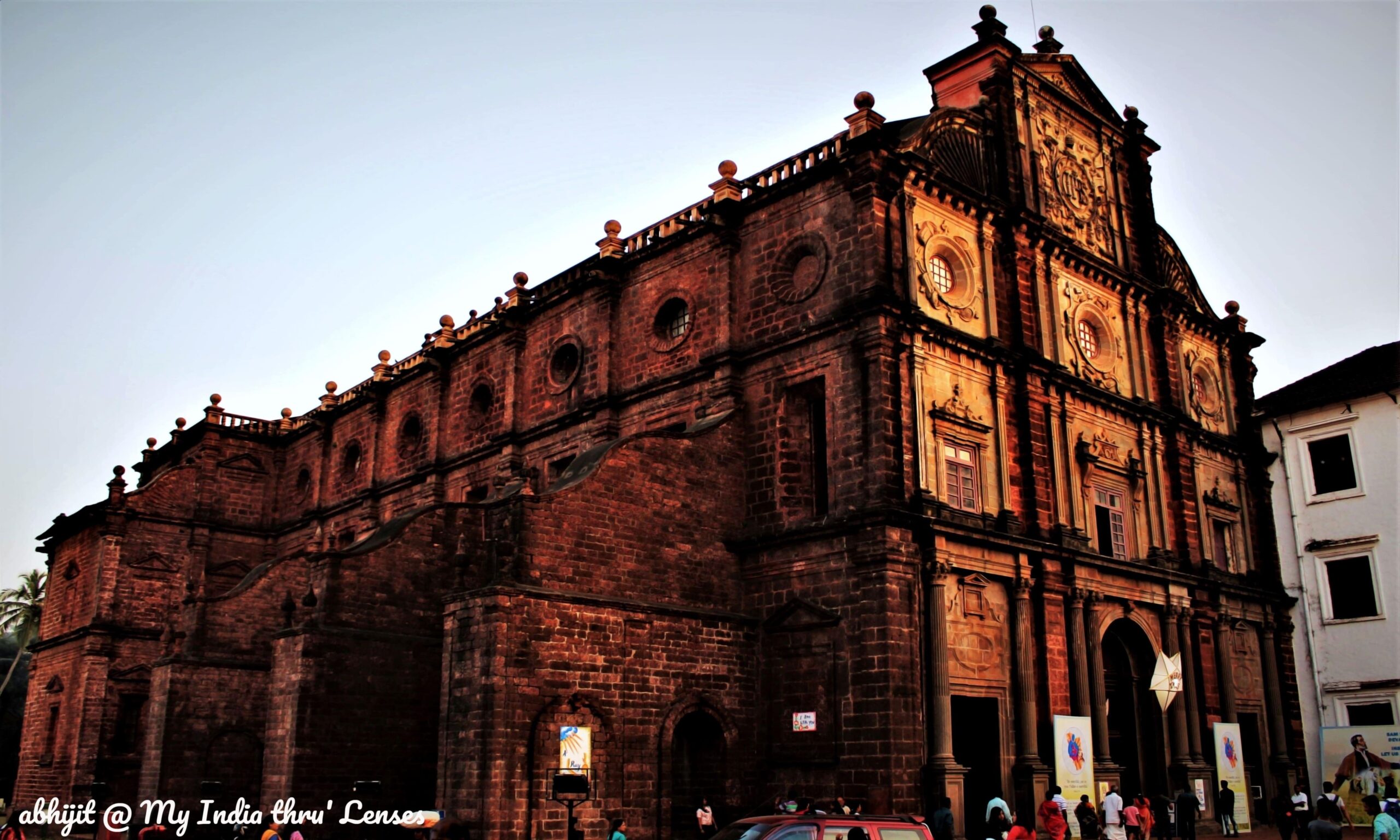
Goa, the smallest state of India, is one of the most visited holiday destinations attracting millions of tourists every year. This beautiful state is visited by not only Indians, but also foreign tourists. With its stunning beaches, hip parties and chilled-out attitude, Goa has become famous as the ‘Party Capital of India’. However, unlike the image Goa has built for itself, this beautiful place is beyond just beaches, parties and night clubs. The real essence of Goa lies in its rich history, unique culture and incredible natural beauty. Goa, which was a Portuguese colony for as long as 450 years, presents an excellent blend of Indian & Portuguese cultures. History lies almost everywhere in the state.
Archaeological evidences suggest that in ancient India, the Mauryan and Satvahana empires had ruled this territory. During the medieval period, it was ruled by Hindu kingdoms like Kadamba & Vijayanagar empires and Muslim kingdoms like Bahmani & Bijapur Sultanates, before falling into European hands in the early 16th century. After several attempts by sailors to reach the Indian subcontinent, Portuguese explorer Vasco da Gama finally discovered the sea route to India from European coast passing by the Cape of Good Hope and landed in Calicut in 1498 CE. With this discovery, Portugal got unopposed access to the Indian spice routes creating monopoly on trade of these commodities. A lured Portugal aspired to establish a colonial empire in this tiny territory. In 1510 CE, led by Alfonso de Albuquerque, the Portuguese invaded Goa and defeated the Muslim army of Bijapur Sultanate led by Adil Shah. The Portuguese conquest of Goa also marks the formal beginning of Portuguese colonial rule in Goa that lasted till 1961 when the Indian Army invaded and annexed Goa after a 36-hour-long battle (Operation Vijay) driving the Portuguese out of the territory.
Interestingly, Goa was the first - as well as the last - European possession in India. The territory fell into European hands at a time when major parts of India were under Delhi Sultanate. While the rest of India witnessed political power shifts for quite a number of times (from Sultanate to the Mughals followed by the British & finally Independent India), Goa continued to be ruled by the Portuguese relatively undisturbed throughout a long descent of time (1510-1961 CE). Over this 450-year-long colonial rule, Portuguese culture has heavily influenced Goan culture, cuisine, art & architecture.
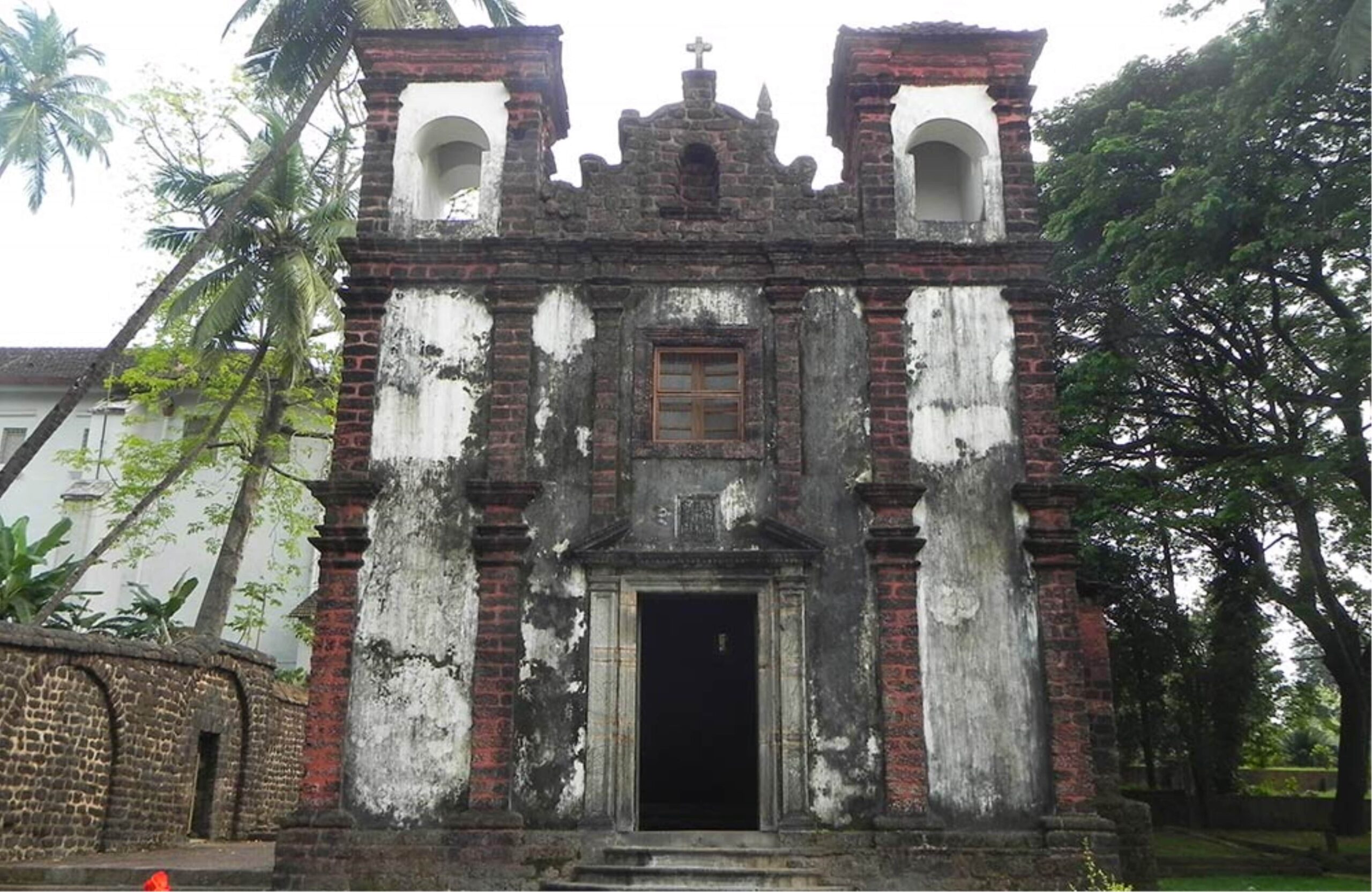
The churches (and also the forts) of Goa are heritage monuments that bear the memories of Portuguese colonialism. Around 50 such heritage monuments lie in various parts of Old Goa, some of which are managed by Archaeological Survey of India (ASI) or State archaeological departments and the rest by local authorities. Apart from having religious importance, the churches & convents of Goa are architectural masterpieces that largely represent an affluent fusion of Renaissance (14-17th century) and Baroque (17-18th century) styles. UNESCO has declared Churches & Convents of Goa as World Heritage Sites in 1986. Primarily, seven monuments have been identified as world heritage sites: (1) Chapel of St. Catherine (2) Church of St. Francis of Assisi (3) Church of Our Lady of the Rosary (4) Basilica of Bom Jesus (5) Se Cathedral (6) Church of St. Cajetan & (7) Church & Convent of St. Augustine.
I have managed to visit close to 25 of these remarkable monuments during my Goa trips at different times and below is a rundown of 10 churches that, according to me, should be on your Goa itinerary. Most of these are world-famous, attract thousands of visitors and come under UNESCO World Heritage list, while a few have remained relatively isolated & less explored. Some of these are located close to busy city centers, while some are located in remote areas surrounded by amazing natural beauty. Each of these architectural marvels has a piece of history attached to it, while a few of these have interesting folklores associated.
01 | BASILICA OF BOM JESUS
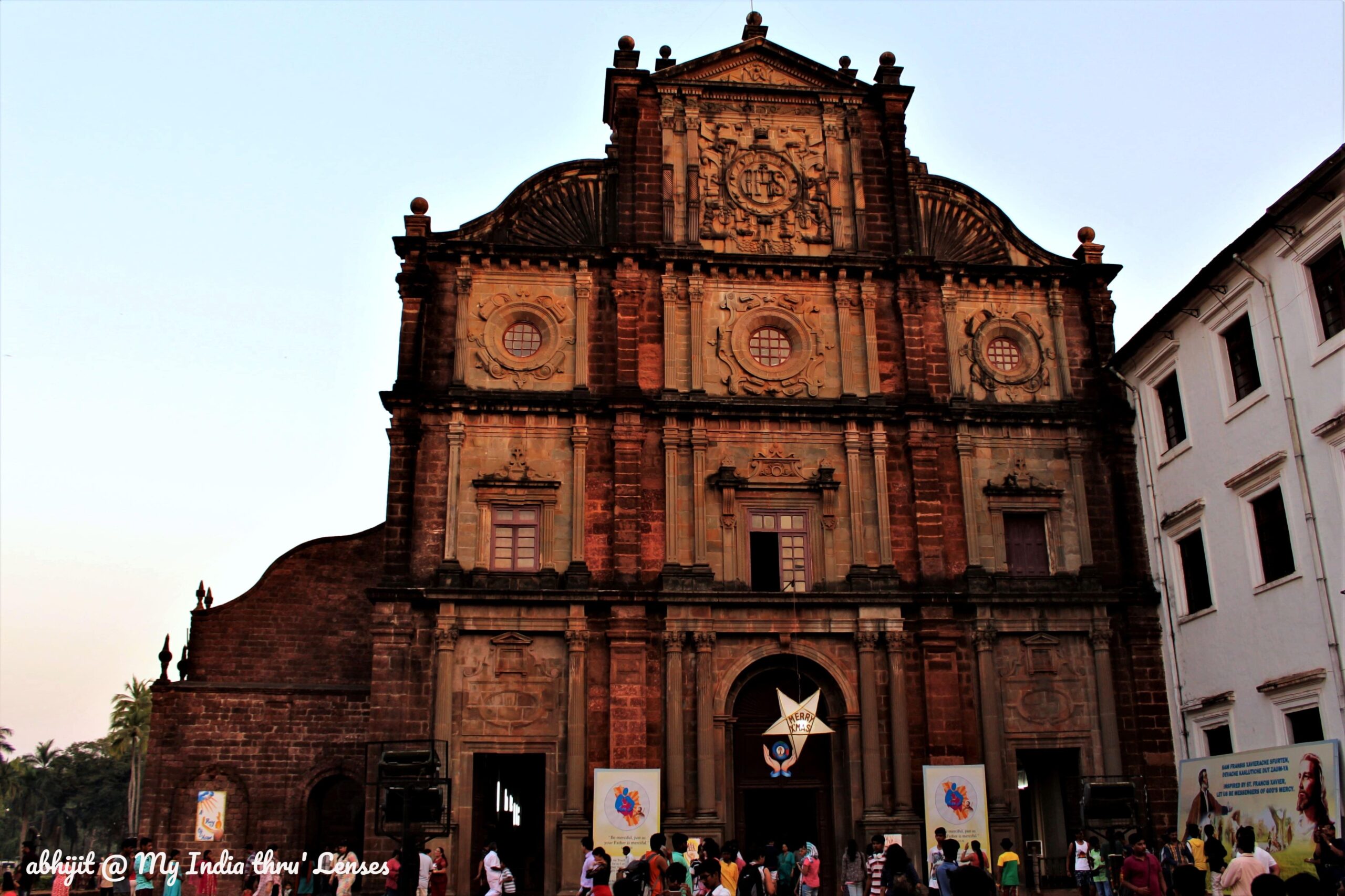
Basilica of Bom Jesus is the most famous church of Goa and is also amongst the churches that are most admired by the Christians worldwide. ‘Bom Jesus’ [meaning, ‘Infant Jesus’ or ‘Good (Holy) Jesus’] is the name used for the Ecce Homo in the places of Portuguese colonization. Located in Old Goa, the Basilica of Bom Jesus is an example of classic forms of architecture introduced by the Jesuits. The un-plastered outer walls give the church a unique look. It is considered to be one of the finest instances of Baroque Architecture combining Doric, Ionic & Corinthian designs. Completed in 1605 CE (foundation stone laid in 1594 CE), the church is one of the oldest churches of Goa. It also boasts a ‘Golden Rose’ conferred by Pope Pius XII in 1953.
Although the interior design is simple, finest marble floorings and basalt pillars could be observed inside the church. Towards the southern side, on a chapel with nicely carved & gilded columns, the mortal remains of St. Francis Xavier is kept. St. Xavier, the patron saint of Goa [read about Inquisition of Goa] died in 1552 CE and in accordance with his wishes, his remains were brought to Goa in the following year. The remains were gifted to the church by Cosimo de Medici III, Grand Duke of Tuscany. The mummified body of the saint now lies in an airtight glass coffin positioned in a silver casket crafted by a 17th century sculptor Giovanni Batista Foggini. A grand ‘Exposition’ of the body is done by the authorities for public viewing once in a decade (next to be done in 2024).
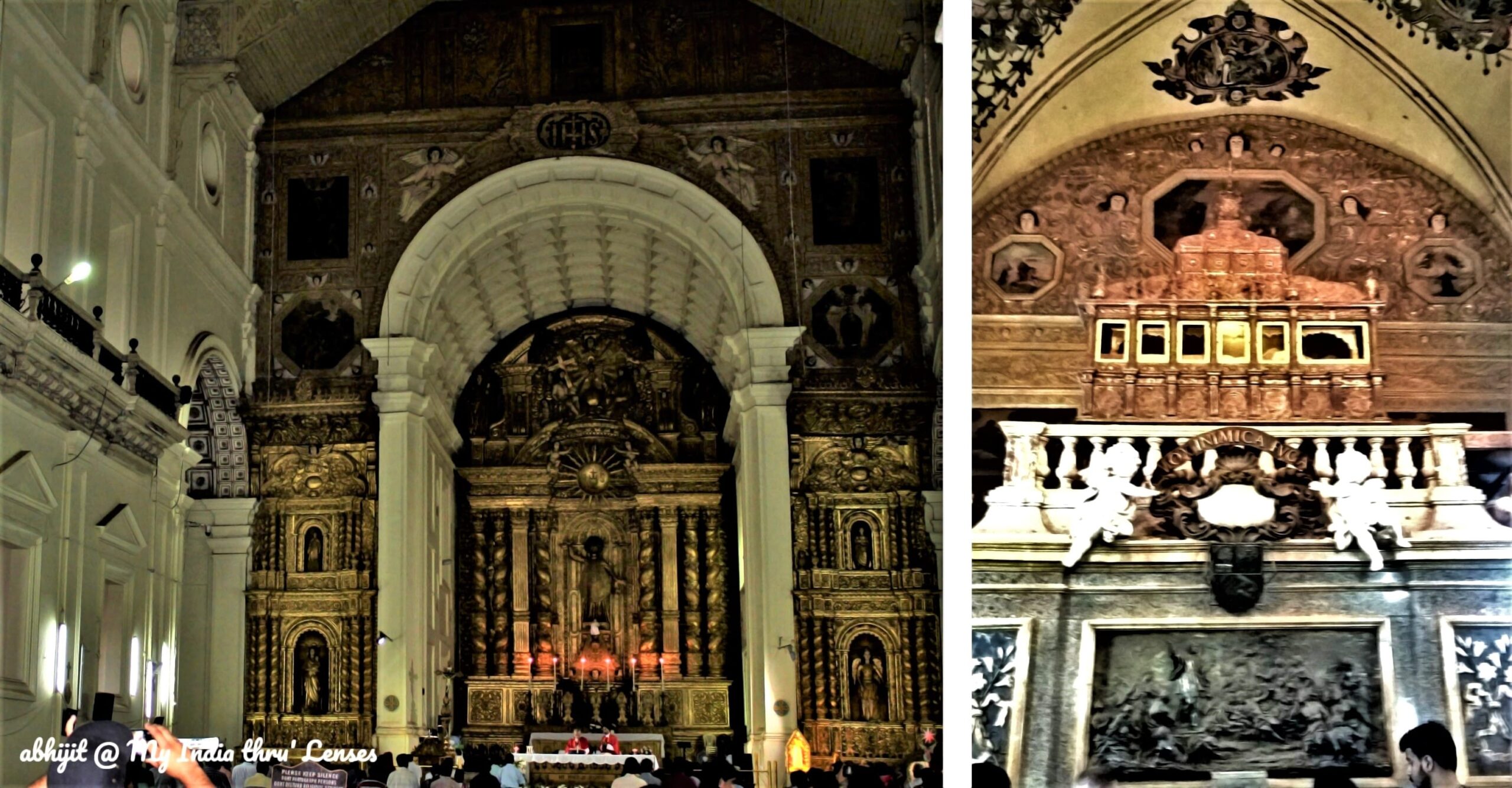
There is also a Modern Art Gallery inside the church with paintings of various biblical scenes, ‘Genesis’ & ‘The Last Judgement’ being the two most famous among them. We visited the church during Christmas times and found both the interior & exterior of the church to be nicely decorated. There were various statues, also depicting the biblical scenes.
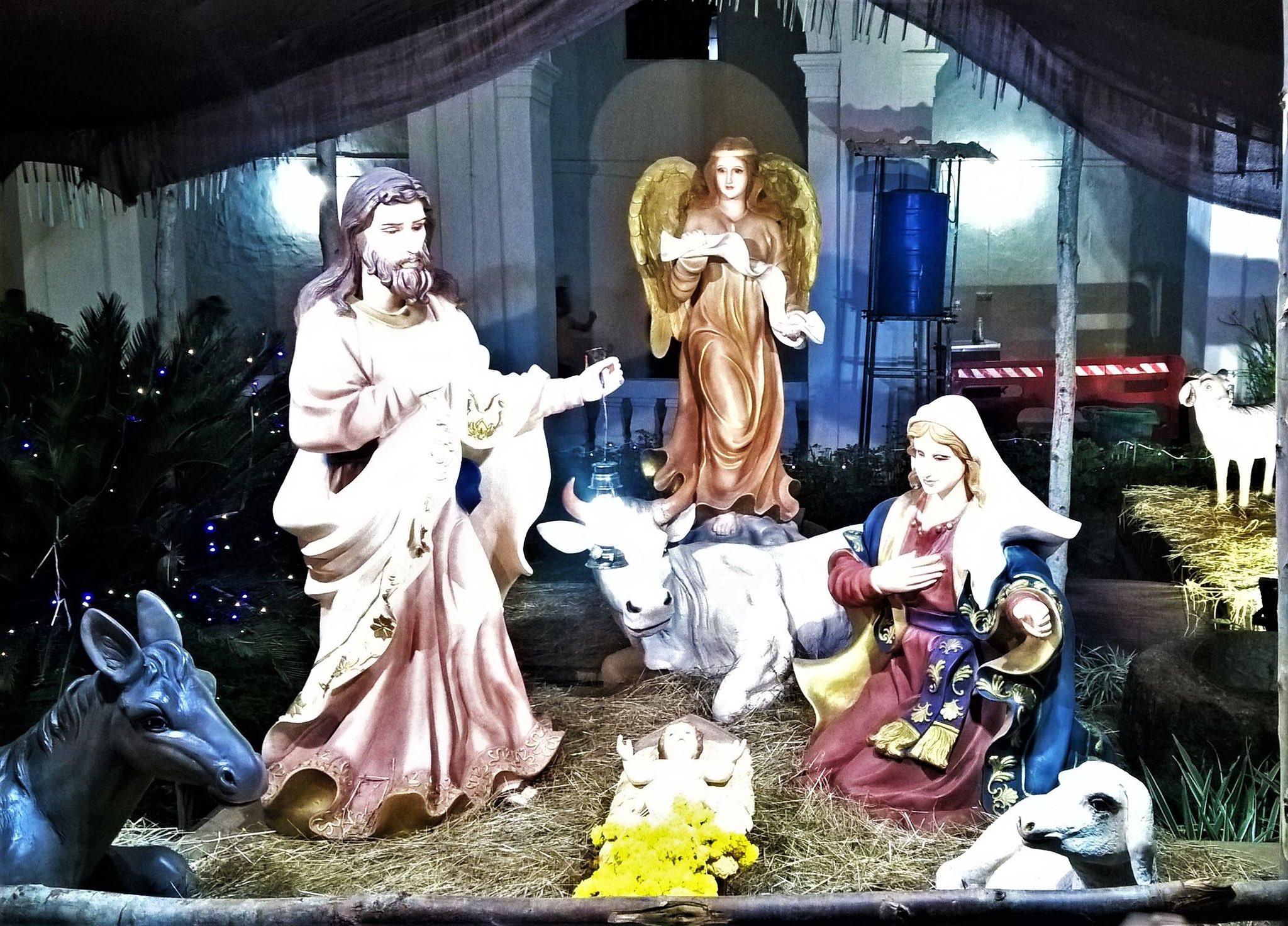
Key Info
- Church: Basilica of Bom Jesus
- Year of Establishment: 1605 CE
- Location: Old Goa Road, Goa
- Timings: Monday to Saturday - 9.00 am to 6.30 pm | Sunday - 10.30 am to 6.30 pm
02 | SE CATHEDRAL
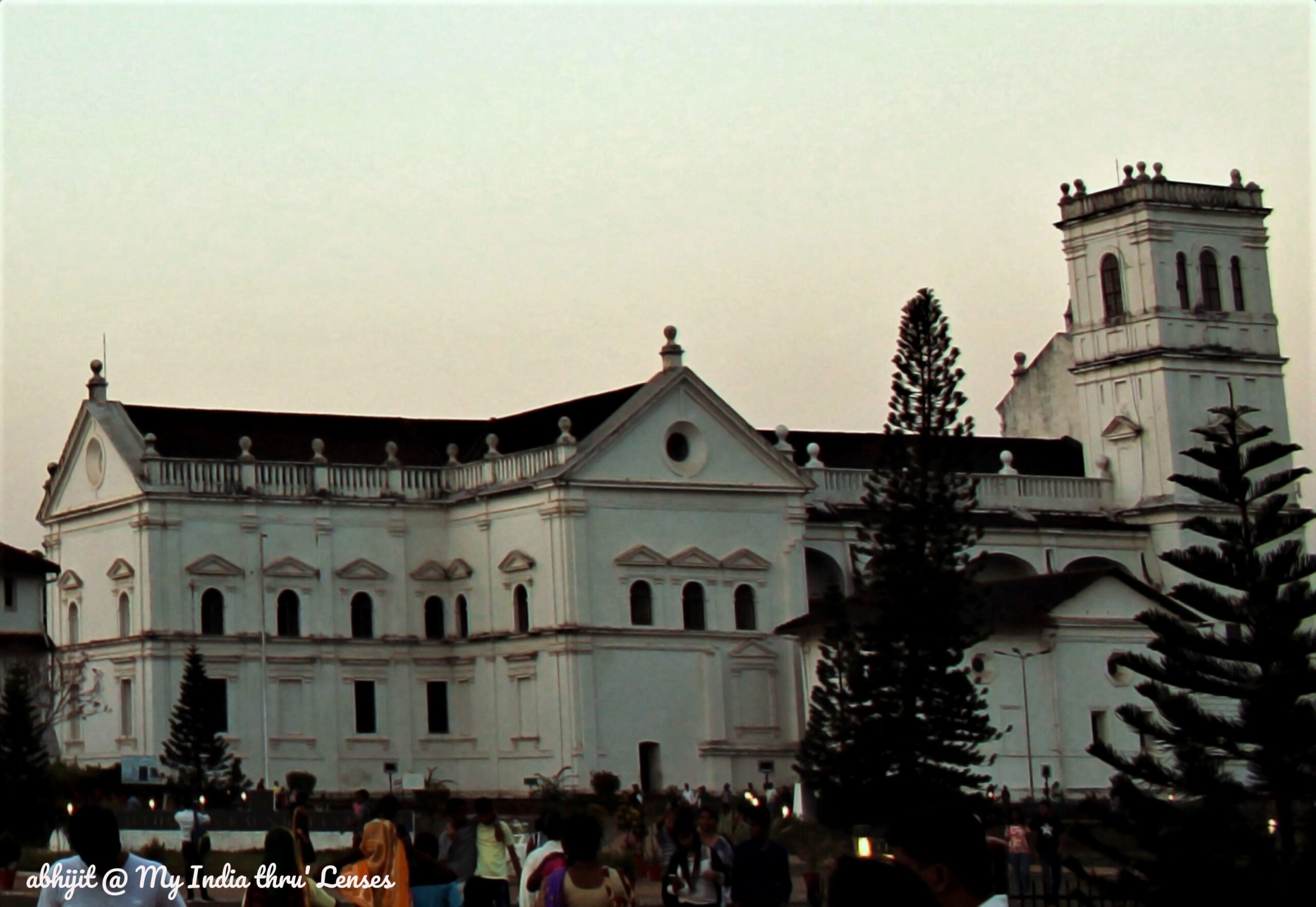
Located in Old Goa, Se Cathedral [aka Cathedral of St. Catherine, Portuguese: Se Catedral de Santa Caterina] is the largest among all the churches & convents of Goa and also one of the largest in India. The church was built to commemorate the Portuguese conquest of Goa in 1510 CE by Alfonso de Albuquerque over the Muslim army of Bijapur Sultanate. As the capture of Goa happened to be on the day same as the feast day of St. Catherine of Alexandria, the Cathedral was dedicated to her. The construction of the church began in 1562 CE and was completed in 1619 CE. It was consecrated in 1640 CE.
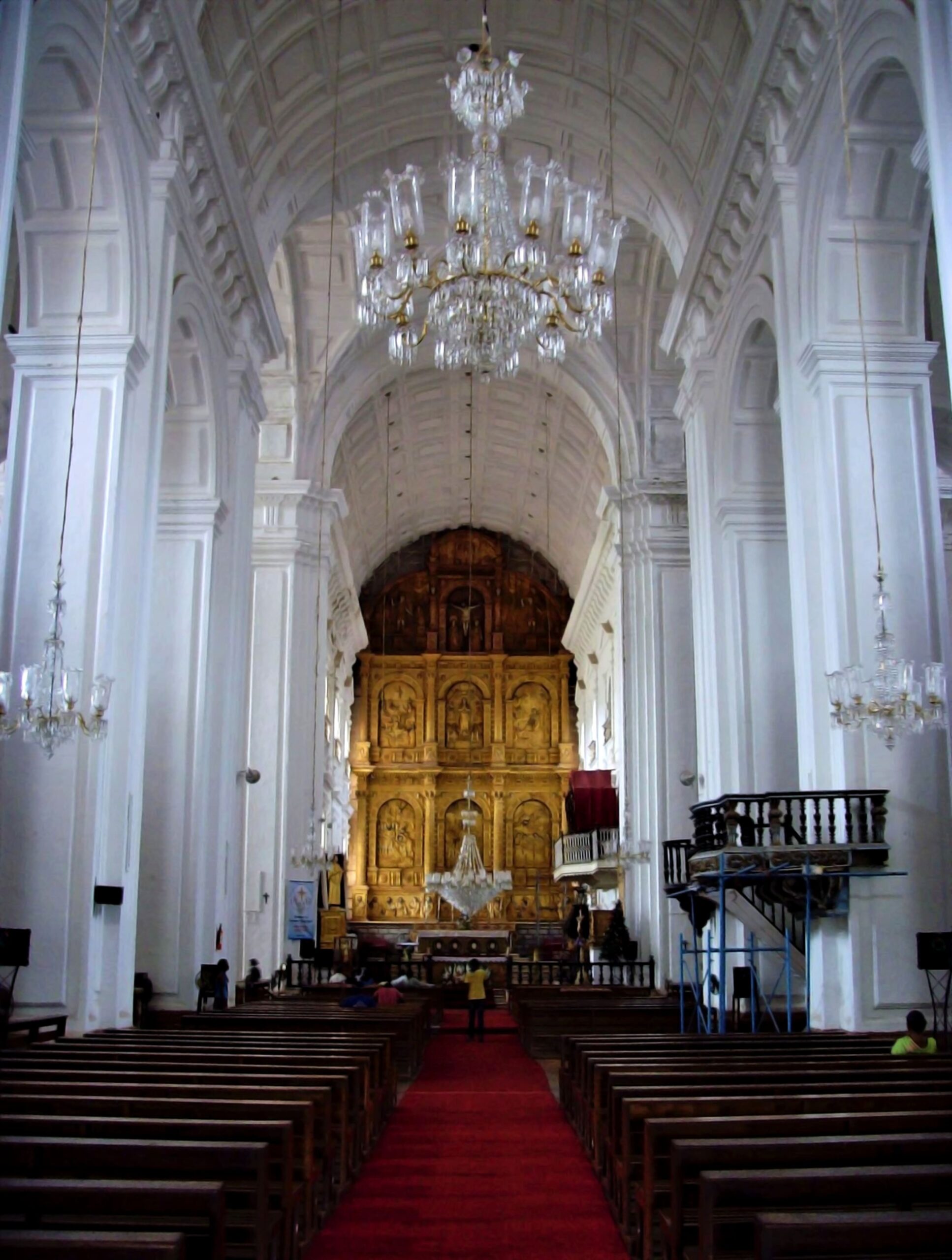
The Se Cathedral is an imposing structure [250 ft (length) x 181 ft (breadth) x 115 ft (frontispiece height)] with superb Iberian façade, soaring ceilings, fabulous mosaic work and intricate wood & gilded carvings. Earlier, the church used to have two towers, one of which collapsed in 1776 and was never rebuilt. The church is an example of Portuguese-Gothic architectural style with Tuscan exterior and Corinthian interior designs. Se Cathedral also boasts the ‘Golden Rose’ presented by Pope Pius XII in 1953.
There is no entry restriction for visitors inside the church, so you can take a walking tour of this grand structure and observe the magnificent interior design & decorations. Several ancient paintings are also displayed inside church. The best thing is that there is no restriction on photography. The main altar is dedicated to St. Catherine and there are paintings on either side depicting scenes from her life. Another attraction of the church is the bell which is said to be the largest in the state. It is often referred to as the Golden Bell for its rich tone. You can also observe the chapel of the Cross of Miracles, where a version of the Christ is believed to be seen in 1919.
Key Info
- Church: Se Cathedral
- Year of Establishment: 1619 CE
- Location: Old Goa Road, Goa
- Timings: 7.00 am to 6.30 pm / everyday
03 | CHURCH OF ST. FRANCIS OF ASSISI
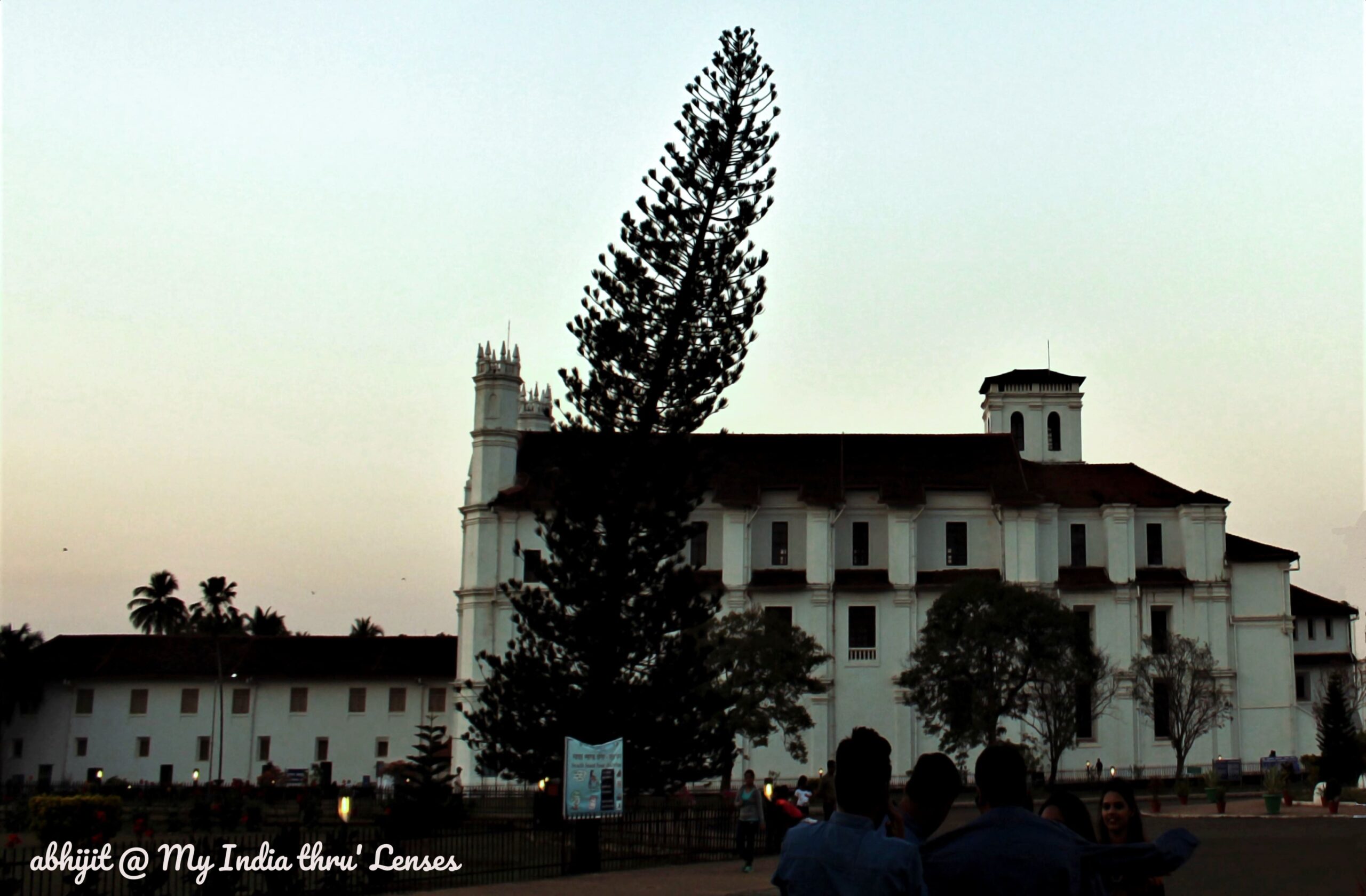
The Church of St. Francis of Assisi is located in the same complex of Se Cathedral. Moving towards west from Se Cathedral, you will see the Old Palace of the Archbishop that serves as a conduit from Se Cathedral to the Church of St. Francis of Assisi. This church & the surrounding convent were originally established in the form of a small chapel by eight Portuguese Franciscan friars, who landed in Goa in 1517 CE. It was modified into a church in 1521 CE and dedicated to the Holy Ghost much later, in 1602 CE. The church that you see today is, however, re-built in 1661 CE on the same spot after demolishing the earlier one.
The Church of St. Francis of Assisi is a blend of various architectural styles. The exterior follows Tuscan style with Manueline architecture in the main entrance. The main altar inside the church follows Baroque architecture with Corinthian features. Key structural elements of the church are the three chapels on both sides, a choir on the first floor, the main altar and two sub-altars. There is only a nave in place of the aisles. The church is best known for its designs, paintings and rich carvings on the altars. The main altar has beautiful floral designs. The walls & ceilings are beautifully decorated with carved wood while the large paintings of St. Francis on the walls add to the beauty of the church. The centre of attractions of the church is, however, the two statues located above the main altar - the first is a beautiful carved wooden statue of St. Francis of Assisi and the second is a statue of crucified Jesus.
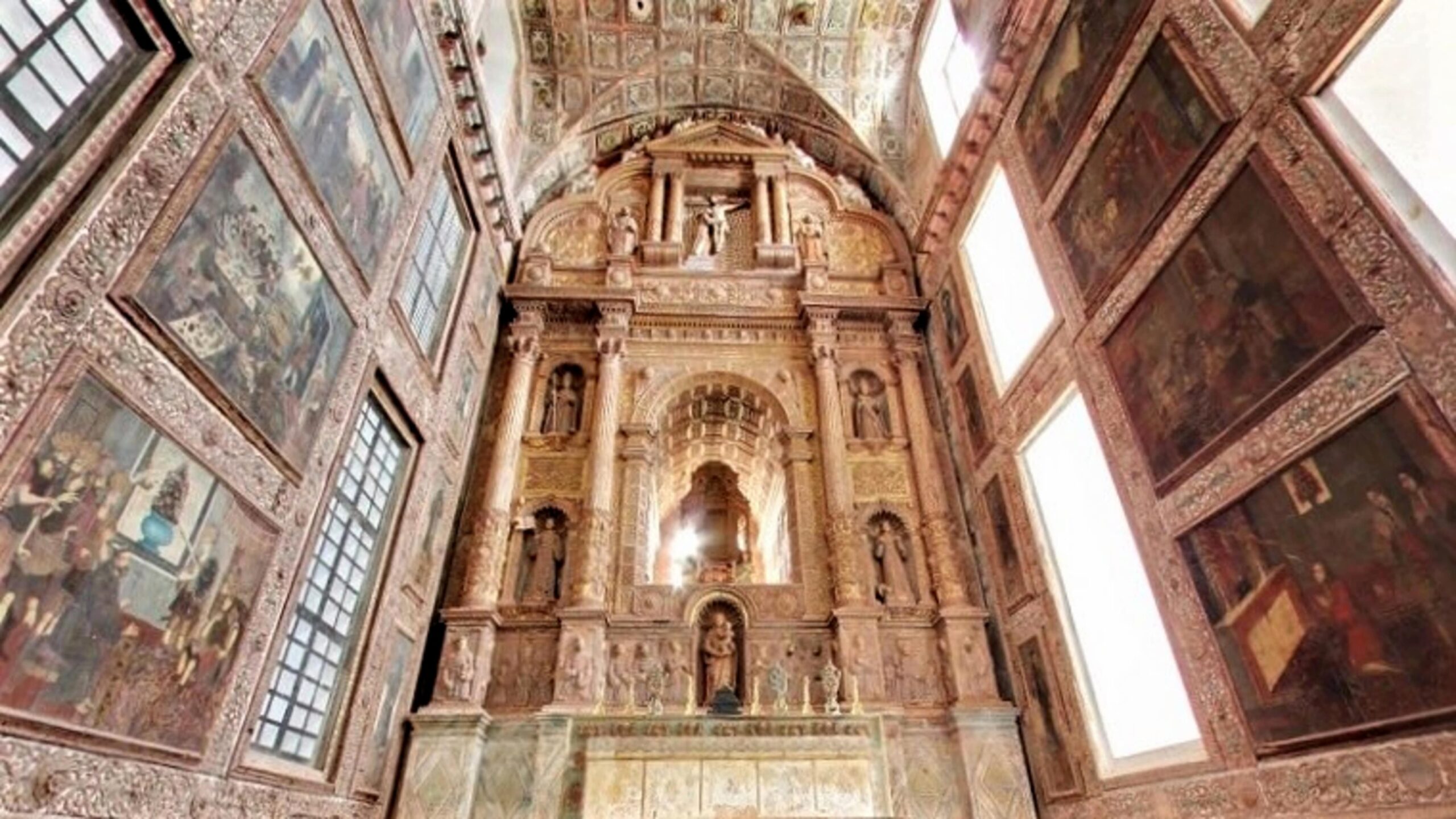
The convent surrounding the church has been converted to a museum by Archaeological Survey of India in 1964. The museum has an excellent collection of artifacts, paintings and pieces of sculptures from the Hindu Temples of Goa.
Key Info
- Church: Church of St. Francis of Assisi
- Year of Establishment: 1661 CE
- Location: Old Goa Road, Goa
- Timings: Church – 7.30 am to 6.30 pm / Museum - 9:00 am to 12:30 pm & 3:00 pm to 6:30 pm
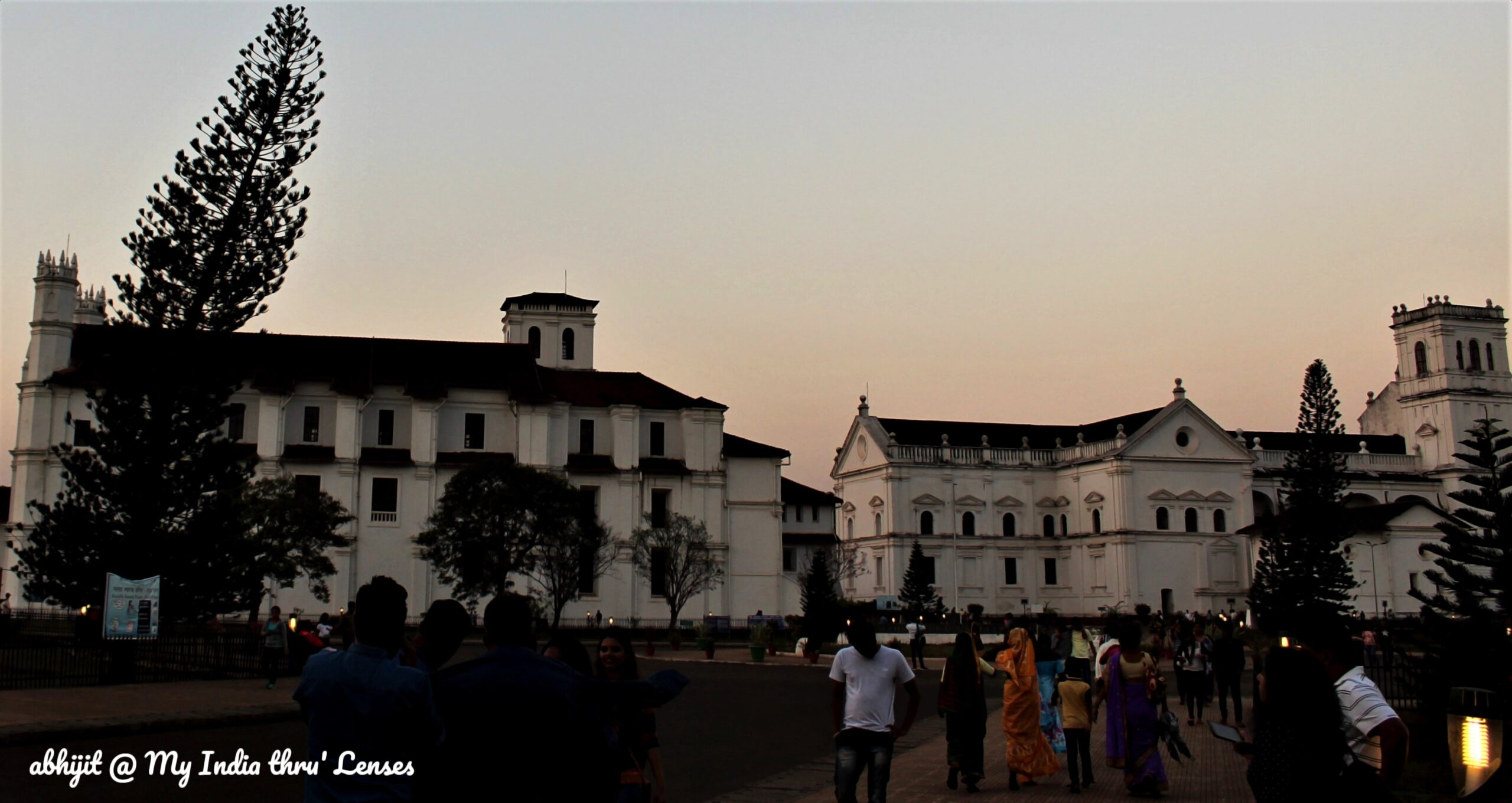
04 | MAE DE DEUS CHURCH
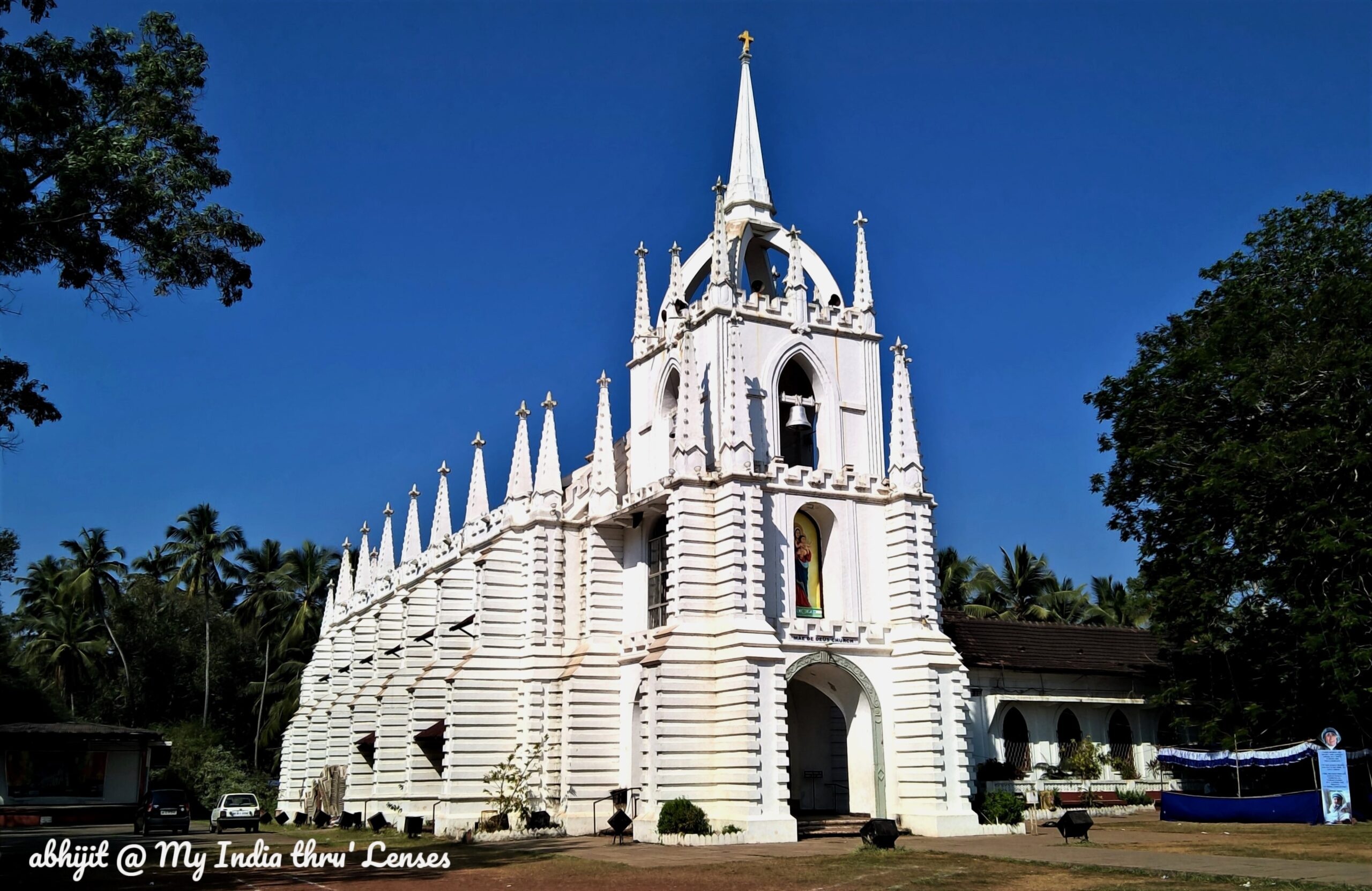
Located amidst a picturesque surrounding of typical Goan countryside, the Mae De Deus (Mother of God) Church at Saligaon (Bardez Taluka) is the only church in Goa with Neo-Gothic style of architecture. Its unique castle-like design with flawless white walls and medieval pinnacles will give you a feeling of the castles from Disneyland. The foundation stone of the church was laid on Feb 7, 1867 and it was inaugurated on Nov 26, 1873. Before the construction of this church, the Saligaon Catholics were part of the parish church of the Holy Trinity at the neighbouring village of Nagoa.
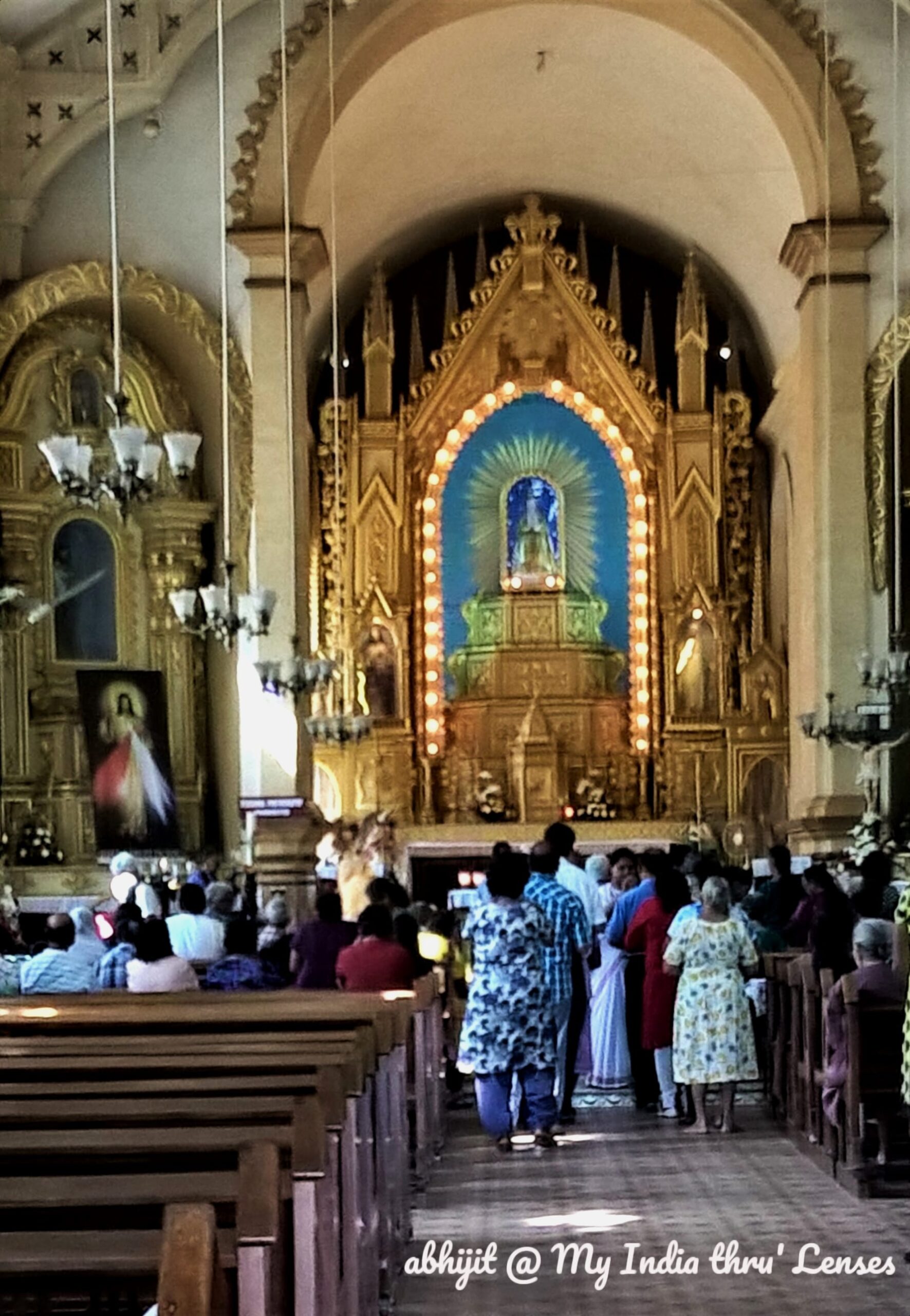
The church building shows the hallmarks of the Gothic architectural style. The pristine white external walls are supported by massive buttresses and have elegant protruding spires. Each spire is crowned with a cross. The courtyard of the church contains a statue of Mae de Deus made of black stone. The interior of the church is equally imposing with gilded & carved ornamentation. Close to the main altar lies the ‘miraculous statue’ of Mae de Deus. The gold-painted wooden statue was brought from the ruins of the convent of Mae de Deus at Old Goa. In addition to the main altar, there are six sub-altars dedicated to St. Francis Xavier, the Sacred Heart of Jesus, the Sacred Heart of Mary, Christ the Redeemer, Our Lady of Assumption and Our Lady of Piety.
At night, the church is very attractively illuminated. You may plan your visit accordingly if you want to observe the stunning night view of the church. The first Sunday of May is celebrated as the church feast day.
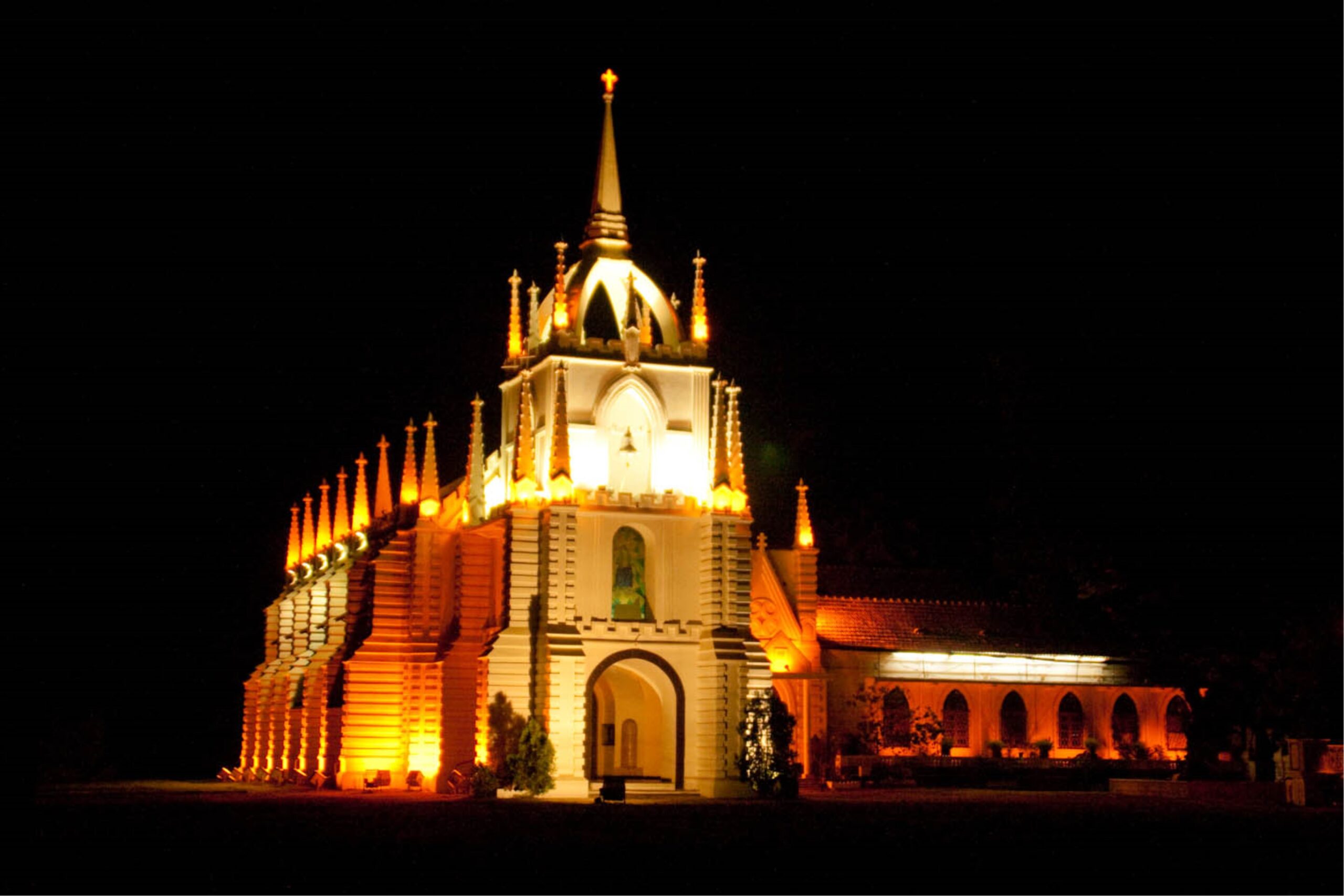
Key Info
- Church: Mae De Deus Church
- Year of Establishment: 1873 CE
- Location: Chogm Road, Saligaon, Bardez Taluka, Goa
- Timings: 9.00 am to 12.00 pm & 4.00 pm to 7.00 pm [Mass timings: Weekdays - 7.00 am & 8.00 am | Sundays - 7.00 am, 8:30 am & 9.30 am]
05 | CHURCH OF OUR LADY OF IMMACULATE CONCEPTION
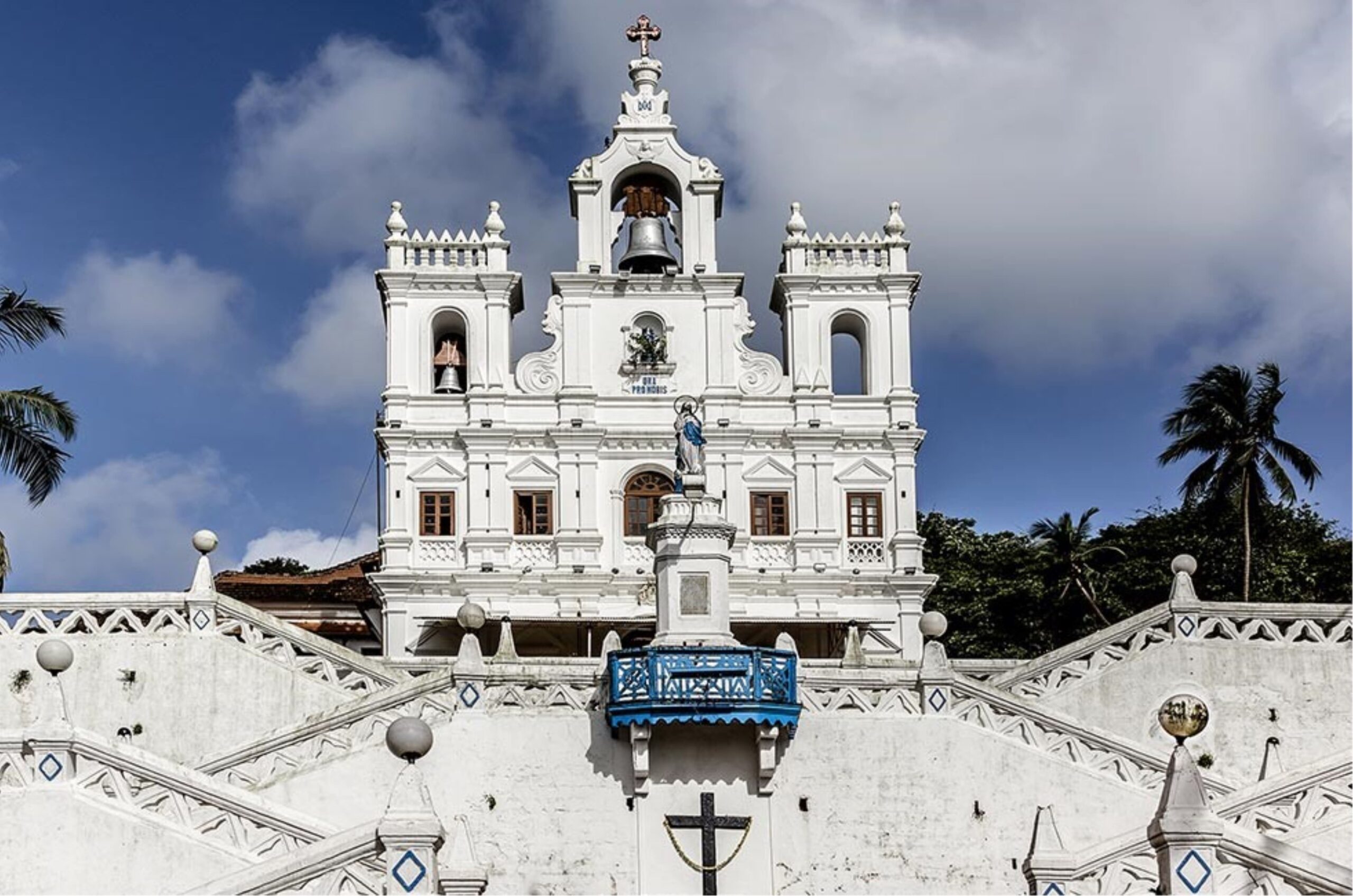
The Church of Our Lady of Immaculate Conception is located at the heart of Panaji, the capital of the state of Goa. It is among the oldest churches in Goa that was initially built (1541 CE) as a chapel to serve the religious needs of the Portuguese sailors in India at that time. Later, in 1609 CE, the building & premises were substantially enlarged to convert the chapel into a church.
A blend of Portuguese-Baroque and Goan architectural styles, this church has a simple, although elegant, exterior. The façade is imposing with two tall towers and even taller belfry. The double flight of symmetrical stairs adds to the beauty of the church. Visible from a great distance, this church is sometimes known as the ‘crown’ of Panaji.
The interior of the church is also simply, but gracefully, executed. There are two altars inside - one dedicated to Our Lady of Rosary and the other to St. Peter. The Xavier’s Chapel within the church is an added attraction. The church houses the ancient bell that was brought from the Augustinian ruins of the Church of Our Lady of Grace and is considered to be the second largest of its kind in Goa.
The church conducts mass every day in English, Portuguese & Konkani. The church feast day falls on 8th December, when the whole church is colourfully decorated and thousands of devotees visit the church.
Key Info
- Church: Church of Our Lady of Immaculate Conception
- Year of Establishment: 1609 CE
- Location: Altinho, Panaji, Goa
- Timings: 9.30 am to 12.30 pm and 3.30 pm to 7.30 pm [Mass Timings: All Days/ 7.00 am to 5.30 pm]
06 | THREE KINGS CHURCH
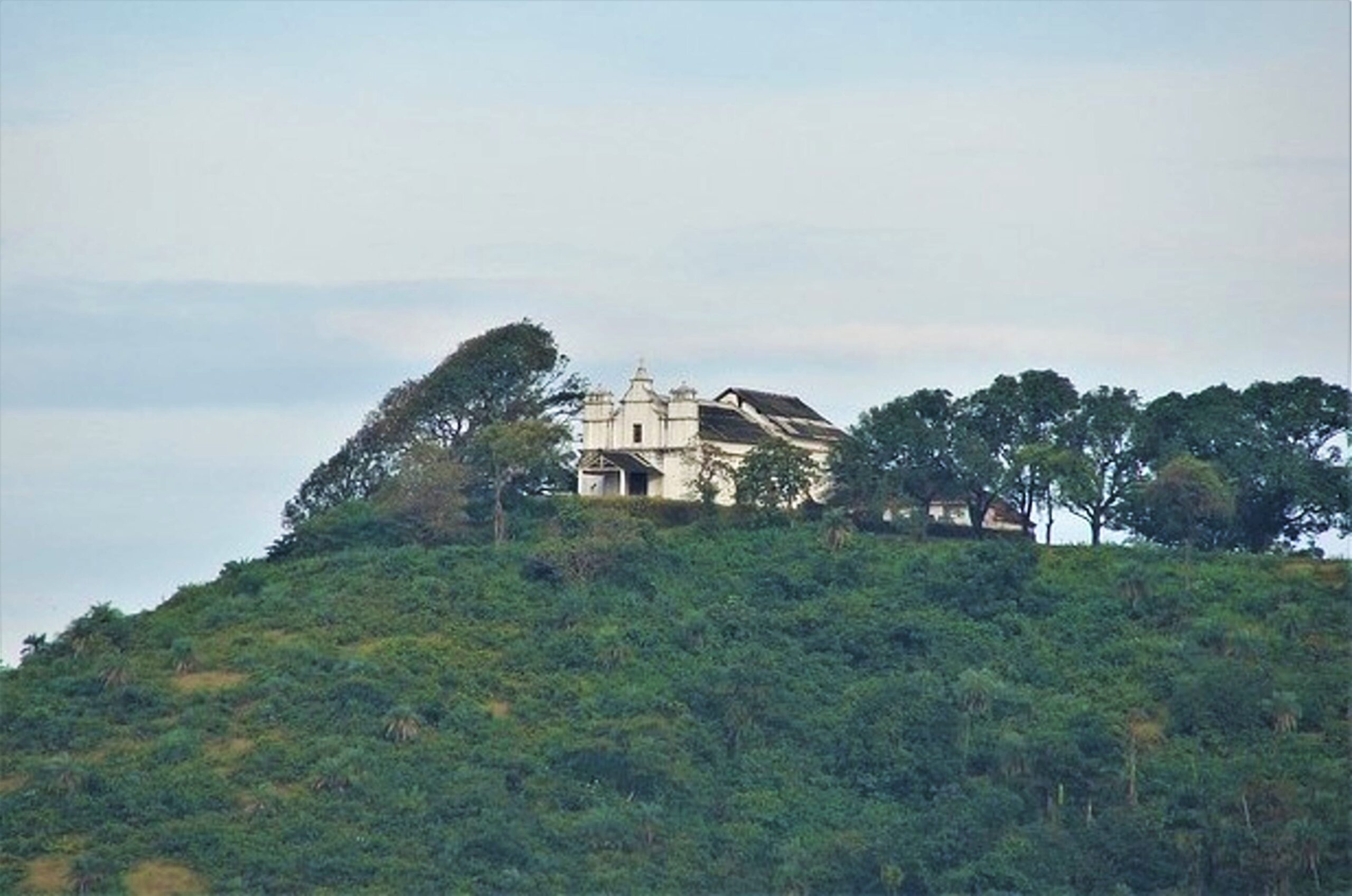
Are you fond of ghost stories or horror movies? There are several spots in India, which have been famous for supernatural activities and Goa is no exception. The Three Kings Chapel, a small lone church located atop a hillock called Cuelim in Cansaulim, South Goa, has been famous for mysterious reasons. There have been a number of claims about paranormal & ghostly activities in & around the church. You will find several YouTube videos and blogs on the church all referring to the associated horror story, which goes like this…
Long ago, during the initial days of Portuguese colonization in Goa, three Portuguese kings (rather landlords) used to live in this region. They were often involved in fight in order to have a control over the territory. Holger Alvunger, one of the kings, once invited the other two for supper with the intention of poisoning them. He succeeded in the conspiracy. However, the news licked and the supporters of the dead kings quickly gathered there along with the local villagers. Realizing that there is no way to get rid of the angry mob, Holger committed suicide. It is said that people buried all the three bodies somewhere in the church grounds. Since then, it has been a common belief among the locals that the spirits of the three kings still roam the place, quietly protecting their territories. Several have claimed about ghostly activities and the place is now listed as one of the spookiest places of Goa.
This church remains closed in the evening and nobody is allowed in the church grounds post sunset. There is a rumour among the locals that whosoever has gone up the hill to visit the church in the evening or at night has never returned. Even during the day time this church is visited mostly by the locals or few odd tourists.

Haunted or not, this church is one of the most scenic spots of Goa. It is worth climbing the small hill and enjoy the breathtaking view of the Arabian sea. Historically, the church was founded in 1599 CE as the “Chapel of Our Lady of Remedies” by Fr. Goncalo Carvalho. However, it is popularised by the name “Three Kings Chapel” derived from the three wise men from the bible, also referred to as the three kings who visited Jesus on his birth. It is famous for the Three Kings Feast celebrated every year on Jan 6th. The present structure dates back to 1721 CE. The chapel is affiliated to St. Thomas Church of Cansaulim.
The Three Kings Chapel is also favourite among film makers, the most recent film shot there being ‘Finding Fanny’. A scene of 2008 Bollywood film ‘Bhootnath’ was also picturised here.
Key Info
- Church: Three Kings Church
- Year of Establishment: 1599 CE
- Location: Cansaulim, Goa
- Timings: 6.00 am to 5.00 pm
07 | CHURCH OF ST. CAJETAN
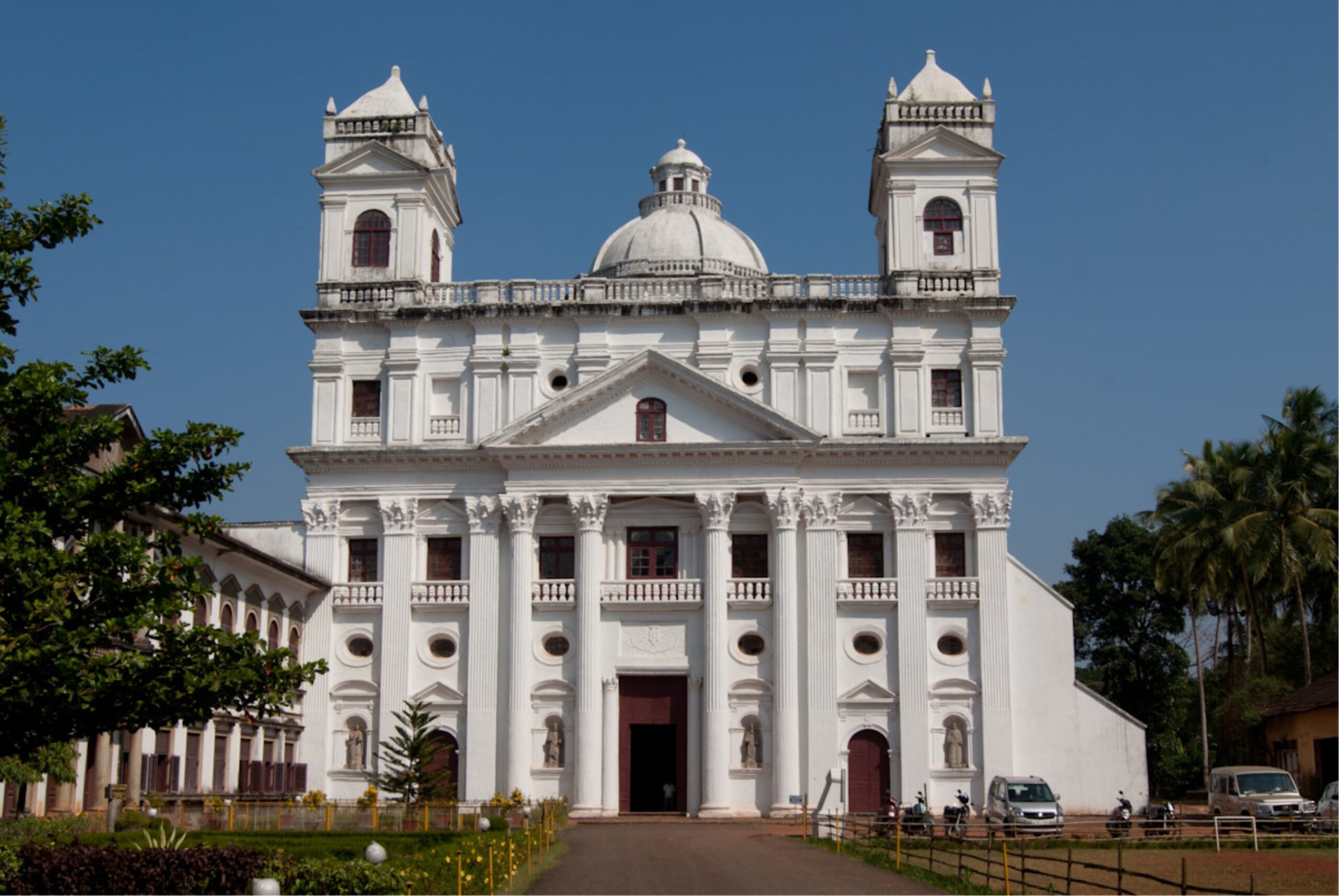
The Church of St. Cajetan, one of the most beautiful churches in Goa, is said to be modelled after St. Peter’s Church in the Vatican City (an enclave within Rome, Italy). The Church overlooks the Mandovi river and is located close to Se Cathedral. Originally dedicated to Our Lady of Divine Providence, the Church is more commonly known as the Church of St. Cajetan, who was a contemporary of St. Francis Xavier and the founder of the Order of monks called the Theatines.
The edifice is believed to have been founded by three Italian priests, way back in the mid-17th century (formally established in 1661 CE). Built with laterite blocks, the Church is an example of Corinthian architectural style. The tower is rectangular in shape and the interiors are divided into different sections. The beautiful main dome with Latin inscriptions and the sculptures at the façade are some of the noticeable elements.
The interior of the church, although predominantly Corinthian, exhibits Baroque, Rococo & Goan influences in some elements including the intricate carvings & gild works. Apart from the main altar, which is dedicated to Our Lady of Divine Providence, there are six smaller altars. You can observe several remarkable paintings, sculptures and wooden statues of saints inside the church.
Key Info
- Church: The Church of St. Cajetan
- Year of Establishment: 1661 CE
- Location: Velha, Goa
- Timings: 9.00 am to 12.00 pm & 4.00 pm to 7.00 pm
08 | CHURCH OF OUR LADY OF PENHA DE FRANCA
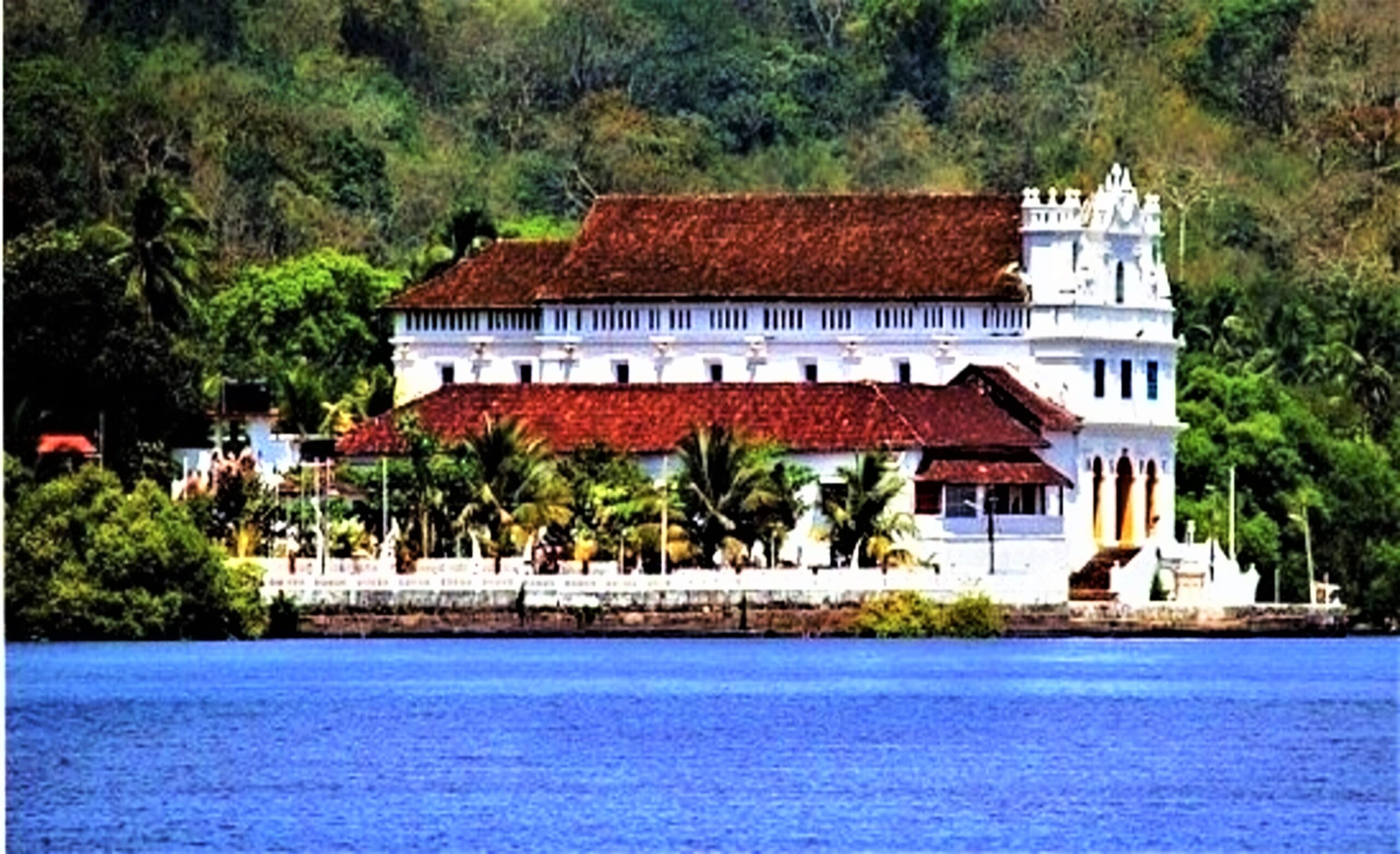
Located in Panaji, the Church of Our Lady of Penha de Franca (Portuguese: Nossa Senhora de Penha de Franca) is yet another architectural marvel with white façade & walls, tiled roofing, high vaulted ceiling, stained glass windows and alluring interior design. The church is named after St. Nossa Senhora de Penha de Franca, a Spanish saint who is believed to have saved Portuguese sailors from a dangerous situation on their voyage to India. After that, Nossa Senhora de Penha de Franca became a kind of patron saint for sailors.
This parish church offers excellent scenic beauty due to its location at the confluence of Mapusa & Mandovi rivers overlooking Chorao Island. It is also one of Goa's most loved and historic waterfront wedding venues.
Key Info
- Church: Church of Our Lady of Penha de Franca
- Year of Establishment: 1626 CE
- Location: Bardez, Goa
- Timings: 9.00 am to 11.00 pm
09 | CHAPEL OF OUR LADY OF THE MOUNT
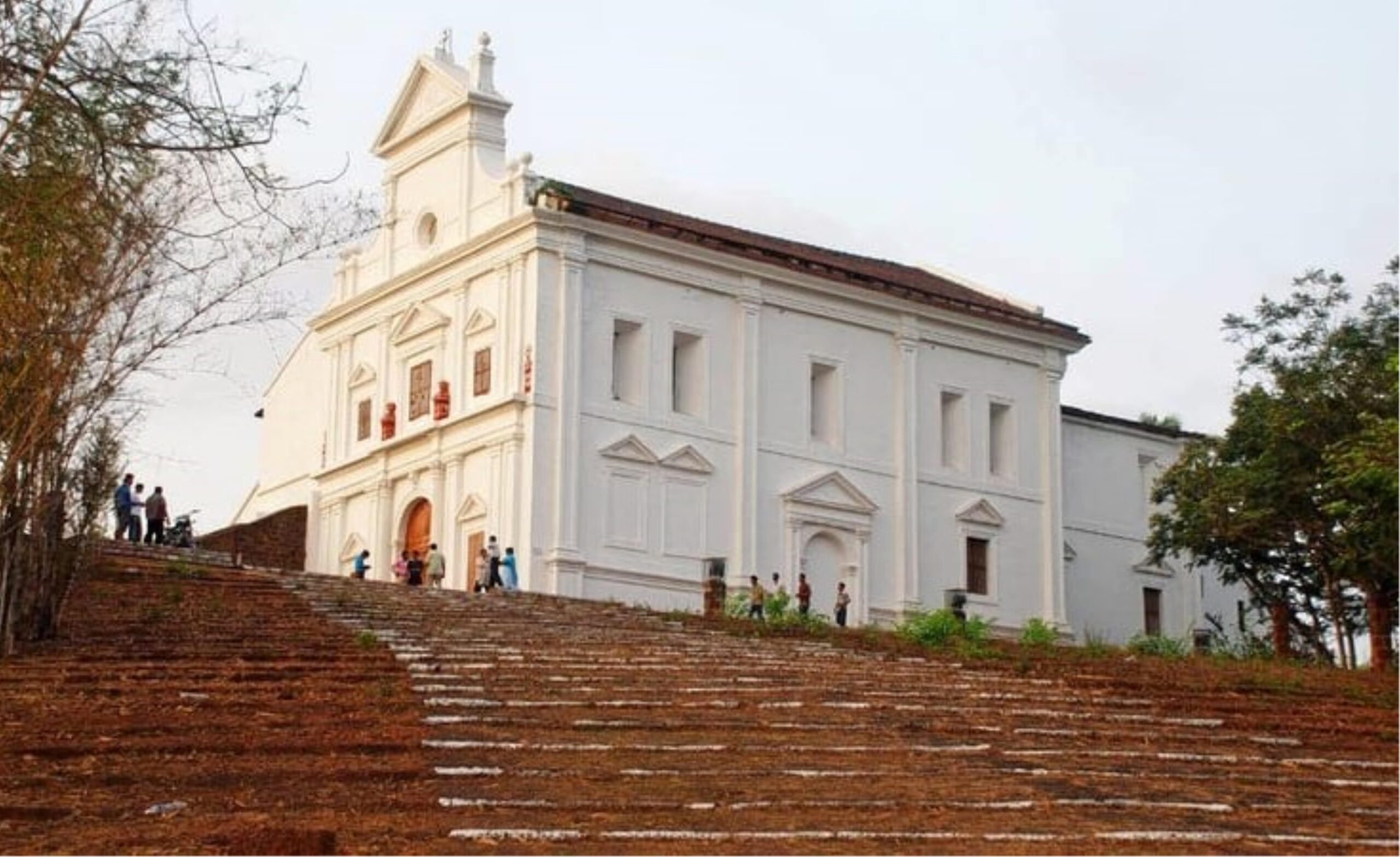
Situated in a relatively secluded location over a hillock in Old Goa, the Chapel of Our Lady of the Mount (Portuguese: Capela de Nossa Senhora de Monte) is a place where nature, peace and history come together. From the Mahatma Gandhi circle, a short & easy drive uphill followed by climbing a series of laterite steps will take you to this 16th century monument. Dedicated to Virgin Mary, this chapel features simple & elegant exterior with three altars and lavish interior filled with old paintings. The church compound offers stunning views of Mandovi river, nearby Divar & Chorao islands and the Old Goa itself. It is also a great place to enjoy sunset.
The construction of this church started way back in 1510 CE on the orders of Alfonso de Albuquerque, immediately after Portuguese conquest of Goa. However, it has been reconstructed twice and renovated recently in 2001. During the battle Sultan Adil Shah’s artillery had taken up the position in the hillock, as understandable from a marble inscription by the Portuguese Archaeological Committee in 1931 saying - “Here the Mohammedan artillery stood against Alfonso de Albuquerque to retake Goa in 1510 CE”.
Apart from historical significance, this church is famous for Monte Music Festival in the month of November organized by Fundaco Oriente in collaboration with Kala Academy. The Festival aims to integrate Indian and Western form of classical music. Performances are organized in the courtyard, amphitheatre and the church itself. Other than this 4-day-long festival and Christmas times, the church compound remains mostly isolated throughout the year. This church has also featured in a few Bollywood movies like ‘All the Best’ and ‘Jeher’.
Key Info
- Church: Chapel of Our Lady of the Mount
- Year of Establishment: 1510 CE
- Location: Ella, Goa
- Timings: Weekdays - 9.00 am to 7.00 pm | Sundays - 9.00 am to 12.00 pm
10 | SAO JACINTO CHURCH
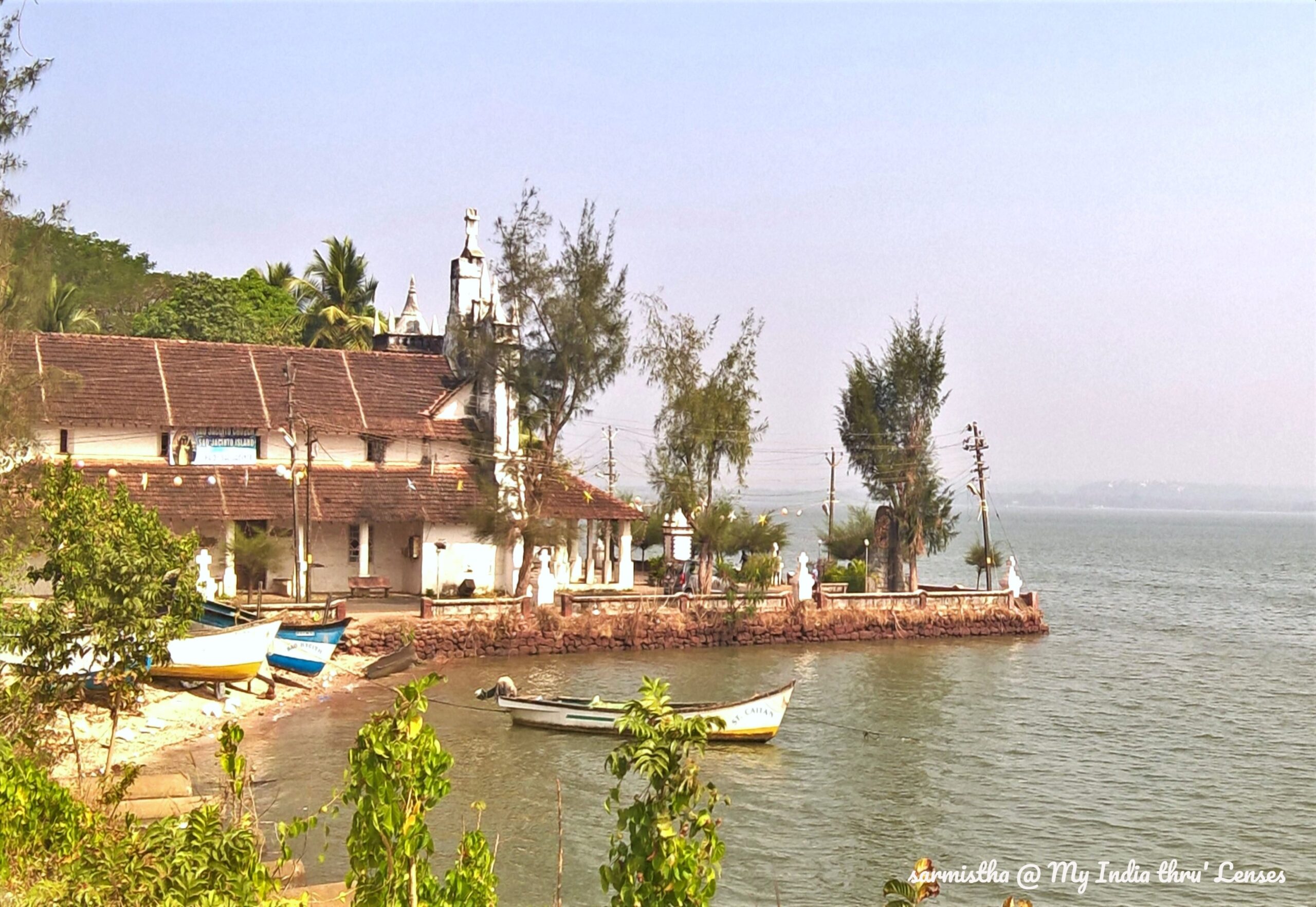
Sao Jacinto is a small & calm island in Panaji on the way towards Dabolim International Airport. This little-known island is located in the Mormugao bay and is approx. 5 kms from Bogmalo beach. It is connected to the coastal Panaji-Vasco highway through a drivable causeway, locally called silver bridge. The island, situated on the estuary of Zuari River, offers excellent panoramic view.
On the edge of the island, there is a tiny white church called Sao Jacinto Church. It is dedicated to St Jacinto, whose feast day is observed on the last Sunday of September. Locally, this church is also known as St. Hyacinth Cathedral. Originally it was established as a Chapel in 1731 CE. It was rebuilt in 1789 CE and further reconstructed majorly in 1830 CE. It was elevated to a parochial church in 1853 CE.
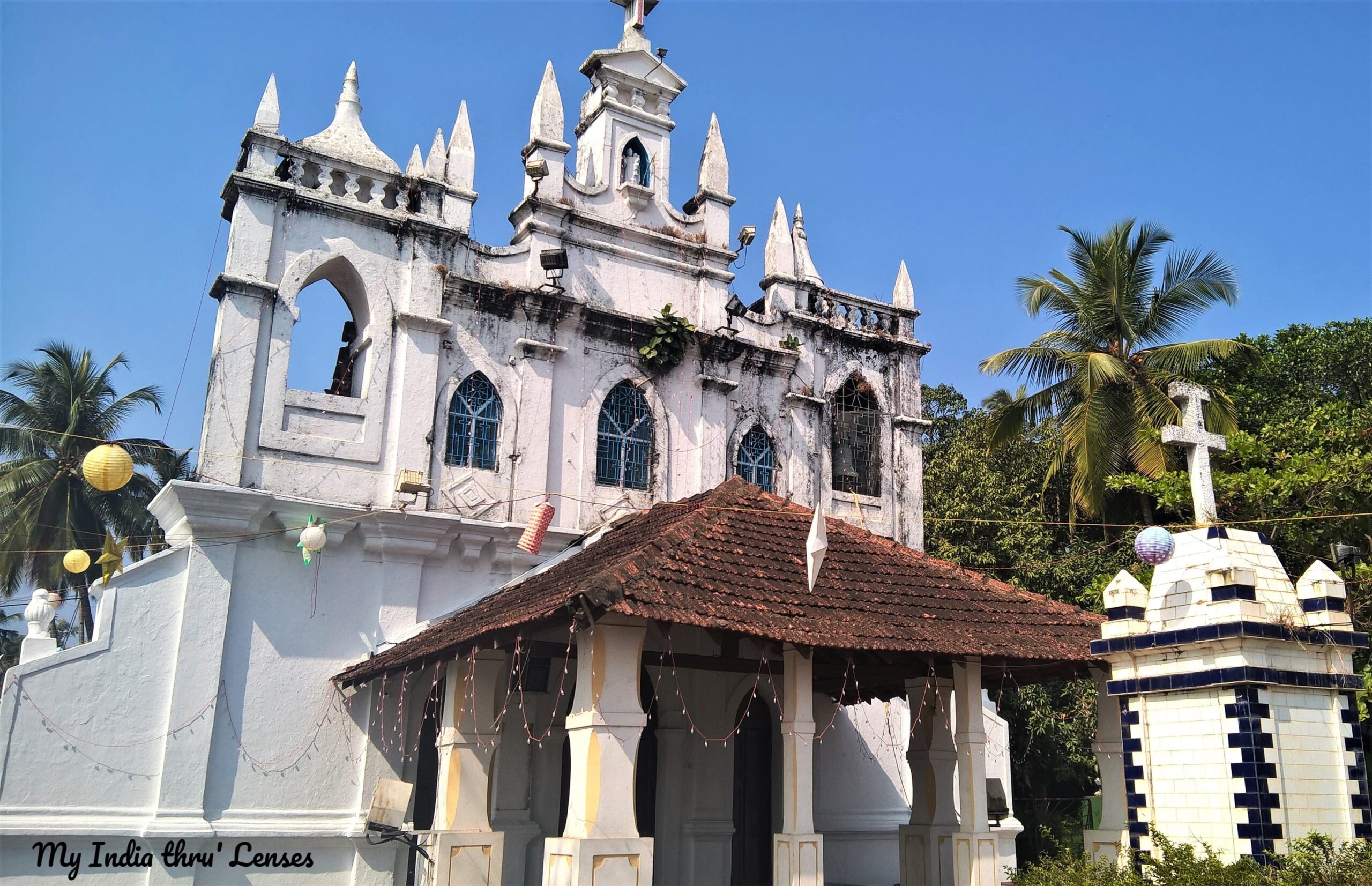
We visited this place on our way towards the airport, however, found the church to be closed. We were informed by the local people that it usually remains open only on Sundays/ during ceremonies. We spent some time sitting on one of the wooden benches, enjoying the serenity of this gracious old church and capturing some photographs of the surroundings. The island also has a very old lighthouse.
Sao Jacinto Island is an offbeat destination that doesn’t fall within the usual tourist circuit of Goa. A google search with “Top 10/15 Churches in Goa” will never show you this church. However, if you are looking forward to spending serene moments enjoying the bounties of nature this place is worth visiting.
Key Info
- Church: Sao Jacinto Church
- Year of Establishment: 1853 CE
- Location: Sao Jacinto Island, Panaji, Goa
- Timings: Open only on Sundays/ during ceremonies
There are several other heritage monuments that have not been included in the above list, but are equally important - Church of St. Augustine (a ruined church complex), Chapel of St. Catherine, Church of Our Lady of the Rosary, St. Alex Church, Church of Our Lady of Miracles and St. John the Baptist Church are only a few among those to mention. Actually the small state is dotted with plenty of churches & convents belonging to the Portuguese era. Grand in design and paramount in historical significance, these churches are not just religious places of worship, but architectural marvels having a class of their own.
View related posts:
Fort Aguada – The most strategically located Portuguese Fort in Goa